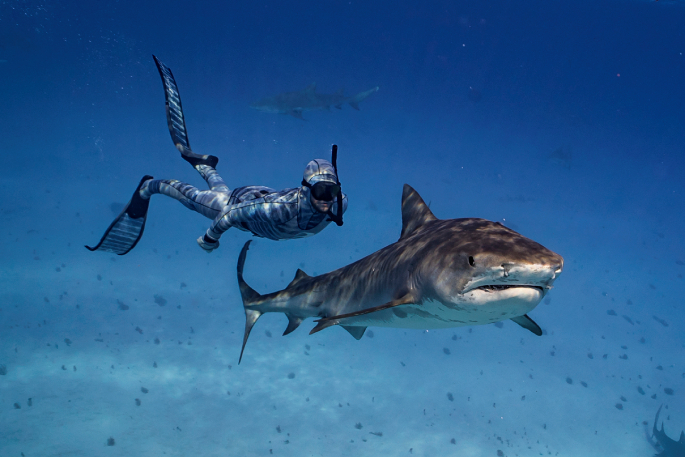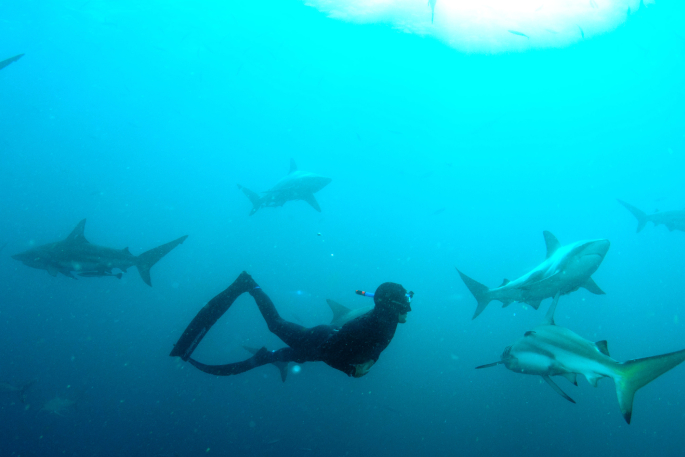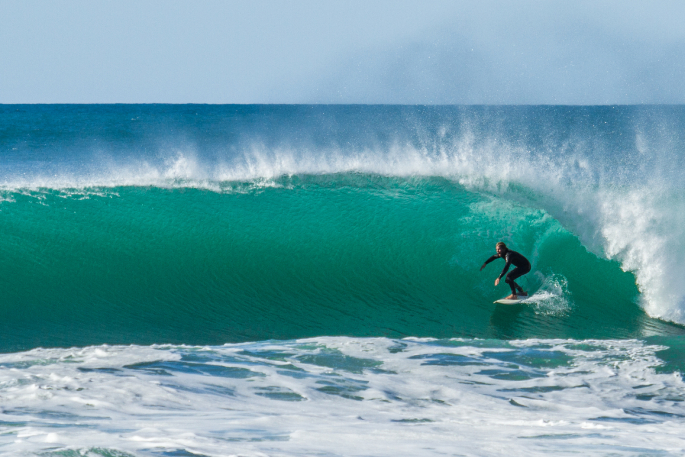Dun-uh. Dun-uh. Dun-uh.
Sharks are often portrayed as man-eating predators in Hollywood movies such as ‘Jaws’, leading to a widespread misconception about their behaviour.
Shark Man Riley Elliott says, contrary to the Jaws movie, Great Whites don’t eat or hunt people.
“They aren’t man-eating machines,” says Riley. “And beyond that, these animals are incredibly important for the health of the marine ecosystem.”
He says this is an endangered species with a relatively small population.
“And because of that they’re protected and we should do everything we can to try and learn more about them and conserve them for their sake and our own.”
Riley says it’s understood that Great Whites make a handful of mistakes on a global scale by biting people whether it purposely or as a mistaken identity bite.
“Each of those creates high trauma and distress for families, friends and also the communities and economies that utilise the water in areas where these happen.
“The impact on the community is so large because it’s such a rare thing to happen and yet it involves such a mystical beast that has been given a Jaws reputation making the reaction far out of balance.
“It’s important to register that in general, animals are incredibly smart, cautious and polite predators.”
He says we very rarely hear of lions, elephants, tigers, crocodiles, or sharks killing people, but it happens.
 Shark are an essential part of the marine ecosystem. Photo supplied.
Shark are an essential part of the marine ecosystem. Photo supplied.
“But when you think of the billions of people that are encroaching on their habitat every day and how much easier we are to catch than their natural prey, it’s truly incredible that it doesn’t happen more often, which proves that these animals don’t hunt us.
“It’s all about context - the statistics really reflect that sharks know what they hunt, and if they wanted to hunt people, we’re pretty easy to catch and it would be happening every single day, but it’s not.”
Riley says when you see pictures and videos of sharks you generally see them facing the camera with their mouths open wide and bare teeth.
“If you put a bait on the end of a rope and you throw it out and the shark comes towards it and then you pull it away, it’s going to open its mouth and try and catch it.
“This is where 99 per cent of photos and videos come from because it captures the imagination of an audience.”
He says in reality, 99 per cent of the time these animals are very calm, cautious and calculated.
“That is because if they get injured and lose an eye, they can’t hunt and they will die.
“Usually they’re swimming around in the most efficient energy-conservative manner until they see what their natural prey is and then they use their capabilities.”
Riley says that’s why it’s important to put it into perspective.
“Hundreds of people drown every year in each country, thousands of people die in car crashes, and yet we’re not banning swimming or stopping people driving cars.”
 "They are a critical, cautious, calculated piece of the ocean that we need for our survival," says Riley. Photo supplied.
"They are a critical, cautious, calculated piece of the ocean that we need for our survival," says Riley. Photo supplied.
Riley says that it is devastating when an attack happens and in some countries, lethal measures have been taken like nets and drum lines.
He says these have been proven ineffective in reducing the risk of shark attacks.
“It’s important to understand that there are non-lethal solutions like beach surveillance, drone surveillance, tags and tracking, alerting systems and apps.
“This is a wild environment. Just because we want to go swim in our Speedos, it doesn't make it any less wild.
“We’re going into a very capable predators’ world and we’re looking like a struggling panicking piece of prey, in fact, we dress like them sometimes as surfers.”
Riley says the most attacked water users in the world by sharks are surfers.
“When you put it into context that we dress up in the same colour as the prey of these animals like seals, we surf in areas where these seals hang out and where these sharks are hunting them, and we act like a very poorly swimming or injured seal by floating on the surface or splashing around paddling.
“Therefore if you dress like prey, act like prey and hang out where prey is, you don’t have to be a mathematician to realise that a predator might react to that.”
He says that surfing is such an enjoyable sport that generally most surfers accept that very small risk because of the reward that surfing is so enjoyable.
 Riley surfing. Photo supplied.
Riley surfing. Photo supplied.
“At the other end of the spectrum being the everyday punter at the beach going swimming, you’re rarely overlapping with where these sharks are hunting and you look very different to their natural prey.”
Riley says perspective is the key thing in understanding the harm that the sharks can cause.
“The greater harm relative to sharks is if we start removing them from the ocean.”
He says in the last 50 years, humans have killed 70 per cent of the world’s large sharks.
“These animals, for hundreds of years have maintained the health of the ecosystem that provides us with food, tourism opportunities, and business opportunities and even down to the very air we breathe.
“For example, in South Africa, where great whites have largely vanished from the global hotspot where there is a hundred million dollar shark cage dive industry which employs a lot of people and brings money into communities, and that’s gone.”
Riley explains the ecosystem like it’s a house of cards all stacked up from the bottom of the food chain to the top where the Great White is.
“If you take the Great Whites out of the ecosystem the whole house of cards falls and an imbalance is formed on a system that has been established over hundreds of millions of years.
“The absence of Great Whites around the seal colonies means you get what’s called a ‘predator release’.”
He says before, the seals had been cautious because of predators and their numbers were controlled.
Without the predators “they become cocky and grow in numbers”.
“They are not shy and they will needlessly kill things like endangered penguins,” says Riley.
Further down the food chain, fish that seals eat are deteriorating in numbers due to the increase of seals.
“Instead of having the card at the top of the house of cards, which is the great white holding everything balanced, you knock that one off and all the rest start falling.”
He says animals used for tourism, animals used for fisheries to feed people, and plankton at the bottom, which provide half of the air that we breathe, would all start to fall.
“The harm is all down to perspective which is blown way out of perspective when it comes to shark attacks,” says Riley.
The most common shark attacks [or what Riley prefers to call “adverse interactions”] occur when people are overlapping with fish.
He says the most common adverse interactions with sharks occur when people are spearfishing, or swimming where people have discarded fish or put out burley.
“The biggest rule of thumb to avoid an adverse interaction with a shark is not to overlap with their prey or where people are provisioning their prey.
“Statistically they [shark attacks] are so rare, it’s important to understand the large amount of tragedy that a shark attack creates versus everyday car crashes.”
He says shark attacks are too rare to create statistics based on them, “because it is so close to zero”.
“If you look around the room that you’re sitting in right now, every single thing around you kills more people per year than sharks.
“And that spans from a fork to a toilet seat, to your cattle, all the way out to your car.
“We have come a very long way since the Jaw's generation. Children are not scared of sharks because they were taught through shows like ‘Finding Nemo’ as opposed to ‘Jaws’.
 Shark attacks are far less frequent compared to other water related incidents. Photo supplied.
Shark attacks are far less frequent compared to other water related incidents. Photo supplied.
“Children are far more educated than most adults on climate change, fisheries depletion, and unhealthy oceans, and they know that sharks are a key part of that ocean health.
“So it's really up to the adults to either be educated by their children or find the information on their own, to understand that sharks are not dogs.
“They are a critical, cautious, calculated piece of the ocean that we need for our survival.”
Riley says that the Great White Project has been going well this summer.
“This summer has been very quiet as far as great white sightings. It’s interesting and likely related to the shift in climate.
“We still have very warm water which is generally a drawcard for young great white sharks.”
If anyone spots a great white, Riley asks that if it is safe to do so, take a photo and send it to him.
“These sightings are incredibly helpful.”
If you see a Great White please report it to Riley at: nzsharkman@gmail.com.
To report a catching or sighting, call 0800 DOC HOT (0800 362 468), or email: sharks@doc.govt.nz.
Subscriptions to the Great White app cost $5 to fund the project, says Riley.
The app will always be free on the website: www.sustainableoceansociety.co.nz.



0 comments
Leave a Comment
You must be logged in to make a comment.